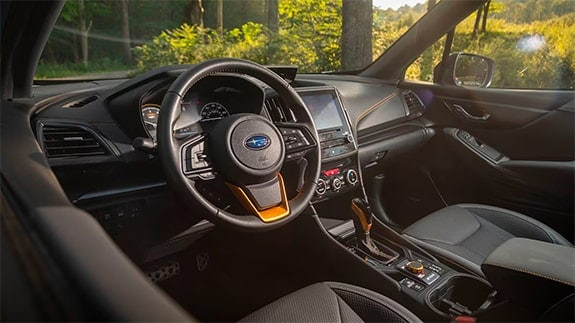
Oh yes we did. Inside Line recently caught up with the only 2012 Lamborghini Aventador LP700-4 rolling display chassis in existence and had our way with it at a nearby Lamborghini/Aston Martin service facility.
What's more, this beautiful piece of one-of-a-kind automotive sculpture has been sold to an unnamed private owner in the Far East. Once it completes a couple more exclusive corporate appearances it's destined to be crated up and shipped to an undisclosed private location, never to be seen again.
I'm totally geeked out. Kurt Niebuhr's shutter finger has never been itchier. Let's get on with it.

I'll try not to muck up Kurt's photos with too many arrows, though some will be necessary here and there.
Before we take the tire off Kurt and I can see we're in for a treat. Aluminum abounds in this gorgeous double wishbone front suspension, but the spring and damper are nowhere to be seen.

De-tired and raised up on a lift, this head-on shot shows what's going on. The Aventador uses what's called pushrod front suspension, a variant of the double wishbone layout that uses a pushrod (green) where a coil-over shock might otherwise reside. The pushod is connected to a triangular bellcrank (yellow) that pivots about a fixed point on the chassis, indicated here by crosshairs.
In open-wheel racers such as Formula One cars, pushrod suspension removes the bulky spring and shock assembly from the airstream to improve aerodynamics. But there's also a significant reduction in unsprung mass, because a slender aluminum pushrod weighs a lot less than a coil-over.

The upper end of the bellcrank bolts directly to its coil-over, which lays horizontally end-to-end with its opposite number from the other side. Wheel lifts lower arm, lower arm lifts pushrod, pushrod pushes bellcrank, bellcrank pushes spring and damper assembly.
Even though they move around a little, the bellcranks and the coil-overs are not counted as part of the dreaded unsprung mass of the car. The unsprung mass tally stops at the pushrod.

That gold collar beneath the spring (beneath from a line-of-force standpoint) is a hydraulic lifting mechanism that allows the driver to raise the front of the car to keep the nose from augering in to driveway cuts and parking curbs. The fluid pipes aren't present, but if they were an application of hydraulic pressure would make this collar grow longer, which would drive the spring into the bellcrank and back through the system, raising the nose of the car.

The Aventador can use the preferred front-steer rack placement (yellow) even though it's an all-wheel drive machine because the engine and transmission are of course well out of the way at the back of the car.
A pushrod layout also makes space for the front drive axles. A pushrod is far more slender than any coil-over, but even here they use a necked-down (green) dogbone shape. Oh sure, we've seen others employ a fork that straddles the axle and then stacks the coil-over on top of that, but that getup requires far more vertical space than a slant-nose supercar like this has to offer.
In other words, pushrod suspension allows a low nose without forcing the use of abnormally stubby springs and shocks that would restrict travel and be difficult to tune.

Here's another view of the same pieces from another angle.

This is the bellcrank. There's a lot going on here, but it also looks bitchin'.

The motion ratio of a bellcrank setup is hard to determine without specific knowledge of several dimensions. Inputs enter via the pushrod, and they arrive well below 1-to-1 with respect to the tire. You'll see why if you go back a few slides and notice where the pushrod connects inboard of the balljoint.
From there, the pushrod's inputs act on the bellcrank at radius R1 (yellow). The bellcrank then presses against the spring at larger radius R2 (green), which produces more spring movement for a given amount of pushrod movement. This increases the overall spring/shock motion ratio realtive to the tire back toward the neighborhood of 1-to-1, possibly beyond.
Meanwhile, the stabilizer bar's drop link attaches at shorter radius R3 (orange), which means its overall motion ratio is closer to 0.50-to-1, maybe less. The stabilizer bar itself has very stubby arms to compensate, so it all works out.

You may have noticed that the upper and lower control arm connect to the subframe with tie-bars, a method of attachment more common in racing and other high performance applications where large bushings aren't necessary to promote ride comfort.

Tie bars are also popular in certain segments of motorsport because they allow for quick alignment adjustments by swapping out shims located between the tie-bar and the subframe. The suspension need not be disassembled to make such changes, only loosened slightly.
Furthermore, the effects of different shims thicknesses can be pre-calculated, reducing the need to make detailed alignment measurements at the track each time you make a small setup change. You still have to measure and reset the toe-in, but you'll know ahead of time how much caster and camber change a given pairing of shims will produce.
Shim-based suspension settings don't creep and move as can happen when eccentric cams are used. Sometimes the fast line around a track involves a little curb-hopping, you know?

The Aventador's front subframe bolts to a carbon fiber "tub", the central carbon monocoque frame structure that gives the Aventador's chassis immense strength and low weight.

Inside the tub are two mirror-image openings in the forward bulkhead. In North American trim, the left one admits the steering shaft and holds the pedal assembly and brake master cylinder, while the right one gives access to the HVAC system. These are of course reversed in nations that drive on the wrong side of the road.

The Aventador's hydraulic power steering rack sits in a crossmember right below the springs. The tiny pinion shaft (yellow) is aimed directly into one of those bulkhead openings.

Six-piston Brembo brake calipers are paired with massive two-piece carbon-ceramic brake rotors.

The ventilated and cross-drilled rotors are said to be good for the life of the car, which isn't as much of a stretch as you might think. No one's putting 100k miles on one of these babies.

The front brakes are stuffed inside 19-by-9-inch forged alloy wheels. And I do mean stuffed.

Moving to the rear, we see more forged aluminum and another pushrod and bellcrank.

The Aventador uses double wishbone rear suspension, with a toe link (arrow). Everything is mounted with tie-bars and the balljoints are massive.

The lower wishbone is biased toward the front such that its front half is a more effective longitudinal load path and the rear half a dedicated lateral load path.

Here we can see that the toe-link (right) and the lower wishbone (left) are almost equidistant from the drive axle, which means they're both sharing the lateral load. Massive balljoints on both underline how much load there is to share.

Here's another view of the same bits. From this angle we've also got a good view of the pushrod (yellow) and its lower mounting point.

As we saw in the front, the pushrod has a dogbone shape and is mounted slightly off center to make way for the drive axle which, by definition, has to be in the middle.

Higher up, the pushrod pushes against a triangular bellcrank that pushes on the spring and lifts the stabilizer bar link.

Unlike the front, input radius R1 from the pushrod (yellow) is about equal to ouput radius R2 (green) at the spring. Therefore, the overall motion ratio doesn't change at the bellcrank and stays at 1-to-1, the ratio it arrived at because the lower end of the pushrod connects directly to the rear upright.
The satabilizer bar motion ratio, on the other hand, is reduced to 0.5-to-1 or thereabouts because its link bolts to the bellcrank at shorter radius R3 (orange).

Here's another view of the bellcrank, the stabilizer link and the very straightforward (and strong) stabilizer bar mount.

The Aventador's rear springs sit well behind the mid-mounted V12 engine. Everything in sight is very well braced.
Yes, that's the muffler. Woof.

Just like the front, rear camber adjustments are made with shims that have been slid behind the tie-bar mounts for the lower wishbone. Only difference is these slip in from the top.

Toe adjustments are made with an eccentric cam at the inboard end of the toe-link because toe settings can't be made effectively if they're restricted to the step changes afforded by shims.

The rear subframe bolts to the back of the carbon fiber tub, bringing the engine, transmission and rear suspension along with it.

Take a moment to go back and look at the McLaren MP4-12C suspension walkaround. That car uses a central carbon tub, too, but it's purely structrual and completely hidden. The body panels are added to offer rollover protection and give the car its shape.
Here we can see that the Aventador's carbon chassis incorporates a full-height rear bulkhead and includes the roof (orange). The a- and b-pillars are also part of this central carbon fiber monocoque. You don't get much rear window, though.

Four-piston Brembo calipers handle the stopping chores at the back end. A single-piston sliding Brembito caliper acts as a parking brake. Both pinch a massive ventilated carbon-ceramic rotor.

None of the above would be of much use without suitable rubber. How do these massive Pirelli P Zeros grab you? They certainly grab the asphalt. For the record you're looking at 225/35R19 fronts mounted on 19-by-9 rims. The rears are 335/30R20 (that's another 50% wider, folks) and they live on 20-by-12 rims. Forged alloys all around, of course.
And that's what you get when you pay supercar money. Too bad it's mostly hidden from sight. Maybe the far eastern dude that bought this roller wasn't so dumb after all. Hard to drive one of these properly without killing yourself anyway. Might as well strip it bare and stare at it with a drink in your hand, impressing the hell out of your friends and business associates.
For the record, Kurt and I had Dr. Pepper.


